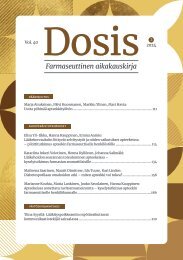Maintworld 1/2020
ROTATING EQUIPMENT SERVICES: A COMPREHENSIVE, WORRY-FREE PACKAGE // SELF-INFLICTED RELIABILITY PROBLEMS OF ROTATING MACHINERY // VIEWING MAINTENANCE AS A SYSTEM TO OPTIMIZE PERFORMANCE
ROTATING EQUIPMENT SERVICES: A COMPREHENSIVE, WORRY-FREE PACKAGE // SELF-INFLICTED RELIABILITY PROBLEMS OF ROTATING MACHINERY // VIEWING MAINTENANCE AS A SYSTEM TO OPTIMIZE PERFORMANCE
You also want an ePaper? Increase the reach of your titles
YUMPU automatically turns print PDFs into web optimized ePapers that Google loves.
the machine. Measure all of them and draw the arrows<br />
again, you will get the first operational deflection shape<br />
of the machine. For finding the next operational deflection<br />
shapes, you have to know the spectrum of vibration<br />
on each point. Knowing the machine shapes is important<br />
for machine understanding.<br />
The ADASH analyzers contain the ADS mode. It enables<br />
you to measure these shapes very simply and then<br />
illustratively animate the results.<br />
In the next example I show you why it is important to<br />
know the mode shapes which are the cause of the vibration<br />
problem. We used the shaker and the rubber cord.<br />
The first natural frequency is 10 Hz and you can see the<br />
first mode shape (Figure 3).<br />
If I need to decrease the vibration level, then I can add<br />
the pillar to many places and it will work.<br />
But sometimes the second mode shape could be the<br />
problem rather than the first. Now you can see the second<br />
natural frequency (Figure 4).<br />
The location of the pillar is now much more important.<br />
If I add it in the middle, then the vibration remains<br />
unchanged.<br />
Back to our first example with the steel beam. Initial<br />
overall vibration was 6.34 g. We added a pillar in the middle<br />
and the main natural frequency on 100 Hz decreased<br />
approximately 4 times. But the second natural frequency<br />
on 280 Hz decreased only about 2 times and now is influencing<br />
our frame almost as much as the first frequency.<br />
The overall vibration is now 3.19 g.<br />
Then we moved the pillar from the middle to 1/3 of<br />
the way between the end pillars. The new natural frequencies<br />
look like this. [3]<br />
You can see that the first frequency remained the<br />
same, but the second was more reduced.<br />
Overall vibration decreased to 2.56 g.<br />
Graph 3: final spectrum<br />
BUMP TEST<br />
MEASUREMENT<br />
IS THE PERFECT<br />
MEASUREMENT FOR<br />
SITUATIONS WHERE<br />
YOU SUSPECT A<br />
RESONANCE PROBLEM.

















